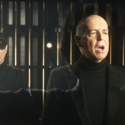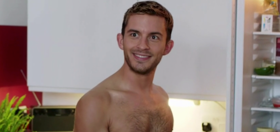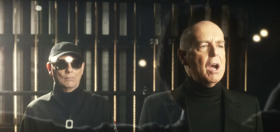
If you’ve read The Celluloid Closet, Vito Russo’s seminal primer for queer cinema, or watched the 1995 documentary it inspired, and wanted to experience the early depictions of gays and lesbian on the big screen, het ready to exclaim “Hooray for Hollywood!”


The 2015 TCM (that’s Turner Classic Movies) film festival will present big screen presentations of such landmark queer-interest films as Queen Christina, Calamity Jane, Rebel Without A Cause and The Children’s Hour later this week in the movie capital. Film buffs will have a chance to watch Greta Garbo, Doris Day, Sal Mineo and other silver screen icons portray coded LGBT movie characters that spoke to audiences when swinging open the closet doors was still taboo. Part of the fun at festivals like this is discovering unseen movies and if you’re not familiar with recently-departed film noir femme fatale Lizabeth Scott, you have a treat in store if you catch her in the steamy crime drama Too Late For Tears. The smokey blond bombshell with the husky voice was an intoxicating screen presence, but had her promising career compromised by being branded a “baritone babe” (code for lesbian at the time) by the scandal rags of the 1950s. If you just want some gay old entertainment in the classic sense of the word, there’s a lavish re-premiere screening of The Sound of Music with much of the original cast in attendance, including Academy Award-winners Julie Andrews and Christopher Plummer. So if you’ve already caught the latest film adaptations of Y.A bestsellers and Disney live-action remakes and happen to be in SoCal, brush up on your cinema history with the dozens of bona-fide classic alternatives here.
The festival takes place in Hollywood March 26-29. For more information including the full lineup, go here. Scroll down to see some of our picks for films you shouldn’t miss.
https://youtu.be/jH77RjQqsKI” width=”420″ height=”315″ frameborder=”0″ allowfullscreen=”allowfullscreen”>
How about we take this to the next level?
Our newsletter is like a refreshing cocktail (or mocktail) of LGBTQ+ entertainment and pop culture, served up with a side of eye-candy.
Rebel Without a Cause (1955)
What’s gay about it: Two of the screens greatest bisexual actors (James Dean and Sal Mineo) are featured in their most enduring roles here in this enduring epic about teenage angst. Even the most naive of viewers will detect the homoerotic longing of Mineo’s Plato for Dean’s Jim Stark.
https://youtu.be/gbvfSGZzR9w” width=”420″ height=”315″ frameborder=”0″ allowfullscreen=”allowfullscreen”>
The Children’s Hour (1961)
What’s gay about it: In director William Wyler’s second film adaptation of Lillian Hellman’s play (his first was 1936’s de-gayed These Three), a vicious, manipulative child spreads a rumor that her two schoolteachers (Audrey Hepburn, Shirley MacLaine) are lesbian and ruins their lives in the process. Shirley, who will be interviewed after the screening, has spoken in the past about how they botched the picture and there was never any discussion of the film’s lesbian themes during the shooting of the movie.
Calamity Jane (1953)
What’s gay about it: The great Doris Day stars as the tomboy-ish titular heroine of the Wild West who can hold her own against the roughest cowboy, but her jaw drops when she sees a pretty lady for the first time. The film’s theme song “Secret Love” was instantly adopted as an anthem about being in the closet.
Boom! (1968)
What’s gay about it: When John Waters calls a movie his favorite, you know it’s going to be not only demented, but loaded with queer appeal. The film is adapted from Tennessee Williams’ play The Milk Train Doesn’t Stop Here Anymore, stars legendary gay entertainer Noel Coward as “the Witch of Capri” and eternal icon Elizabeth Taylor in an outlandish series of gowns and headdresses.
Rebecca (1940)
What’s gay about it: This great gothic romance thrills audiences of all orientations, but Judith Anderson as terrifying housekeeper Mrs. Danvers caressing the panties of her former mistress…well, it’s just about the most sublime imagery for closeted lesbian longing in cinema herstory.
https://youtu.be/5r_gC-CcvYU” width=”420″ height=”315″ frameborder=”0″ allowfullscreen=”allowfullscreen”>
Queen Christina (1933)
What’s gay about it: Bisexual screen legend Greta Garbo has one of her most acclaimed roles — and written by her reputed lover Salka Viertel — as the lesbian monarch and though the censors of the time prevented an honest depiction, Garbo is often clad in men’s wear and is obviously smitten with one of her ladies in waiting.
Earthquake (1974)
What’s gay about it: There’s nothing specifically gay, but it’s a feast for camp lovers and probably the worst — and certainly the most unintentionally hilarious — of the many disaster flicks that cluttered the 1970s. Earthquake employs nearly every melodramatic cliché from the era and there’s the added bonus of Charlton Heston in clenched-jaw, savior-of-the-western-world mode and Victoria Principal bursting out of her T-shirt while wearing a wig best described as a Latina-fro.
Psycho (1960)
What’s gay about it: Alfred Hitchcock’s most-renowned thriller features Anthony Perkins, closeted for much of his life, in his signature role as murderous Mama’s boy Norman Bates.
The Loved One (1965)
What’s gay about it: Based on a 1948 novel by gay writer Evelyn Waugh, author of Brideshead Revisited, the film was billed as “the motion picture with something to offend everyone.” This tale that points a finger at the artificiality of Hollywood features a smorgasbord of gay performers including Tab Hunter, John Gielgud, Roddy MacDowell and even Liberace!
https://youtu.be/HaanE7v6uJI” width=”420″ height=”315″ frameborder=”0″ allowfullscreen=”allowfullscreen”>
Imitation of Life (1959)
What’s gay about it: Queer cineastes have long held great reverence for director Douglas Sirk’s glossy melodramas and this is considered by many to be his crowning achievement. It’s easy to see a gay liberation message encoded in the story of a young black girl ashamed of her identity who tries to pass as white. Besides offering Lana Turner at her most glamorous, if you don’t cry during the film’s tear-jerking climax, you’re dead inside.
Lawrence of Arabia (1962)
What’s gay about it: While World War 1 hero T.E. Lawrence (Peter O’Toole, pictured) isn’t overtly portrayed as the gay sadomasochist he was purported to be in real life, there are plenty of subtle hints about his orientation in this David Lean epic which remains one of the screen’s greatest achievements.


















Billy Budd
Wonderful selection of movies. Lawrence OA is in any serious moviegoer’s top ten list.
jckfmsincty
Also not mentioned, is the great, camp classic, “Suddenly, Last Summer”, With Liz Taylor and Katharine Hepburn.
ingyaom
Norman isn’t just a “murderous Mama’s boy” in Psycho; he’s a murderous cross-dressing Mama’s boy.
ingyaom
“Suddenly, Last Summer” is one of my favorite films. Unfortunately, the gay central character, Sebastian, has already died before the story begins… but handsome young (gay) neurosurgeon, Montgomery Clift, is very much alive.
Billy Budd
I always thought Montgomery Clift was too “stiff” in “Suddenly Last Summer”. Was it filmed after of before his car accident?
Jeremy Kinser
Re: Suddenly, Last Summer (which isn’t included here because it’s not being shown at the TCM festival), Montgomery Clift filmed it approximately three years after his disfiguring automobile accident. Clift was addicted to alcohol and painkillers by 1959 and was considered uninsurable so his longtime friend Elizabeth Taylor put up her own salary as a guarantee to have him cast. Another rumor that swirled from the making of the film, but which has never been verified, is that director Joseph Mankiewicz was very unhappy with Clift’s performance and treated him so badly that when filming ended Katharine Hepburn spit in Mankiewicz’s face to show her disgust.
james_in_cambridge
“Lizabeth Scott’s career was killed by rumors that she’s a Lesbian” makes for a good story but it apparently wasn’t true. According to Wikipedia, “Despite latter claims that Scott’s film career was ruined by the Confidential scandal,[280][281] by the time the September 1955 issue of Confidential appeared, her career was already dormant. Scott had begun her career at a time when many established actors were away at war, giving then unknowns like Scott a chance at stardom. When the older stars returned, many of the newer stars faded away.[282] In addition, the rise of television and the breakup of the studio system further curtailed film production. Film historians generally agree that Scott’s career essentially peaked between 1947 and 1949.[283] By February 1953, her stage fright was such that she even hid from friends.[284] Scott did not renew her Paramount contract in February 1954, 18 months before “Lizabeth Scott in the Call Girls’ Call Book” was published. Between the end of her contract and Rushmore’s article, she had turned down numerous scripts, including a part in Wallis’ The Rose Tattoo (1955).[285] But instead of reinventing herself as Bacall did, returning to Broadway, Scott chose another path.”